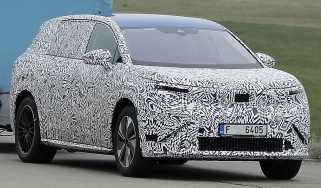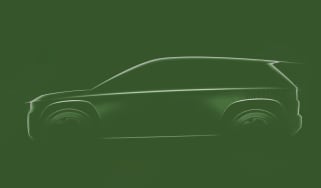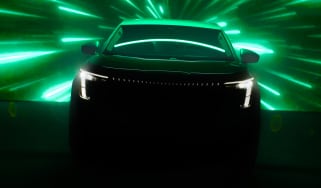Cheap new Skoda electric SUV could be built in India with new battery tech
Skoda is working on a new baby SUV to sit at the bottom of the brand's all-electric line-up, and our exclusive image previews how it could look

Skoda is working on a cheap electric model that will undercut its own ‘baby EV SUV’, Auto Express can reveal. The concept of a 20,000 euro electric car is a major and longstanding challenge for Skoda and other brands in the Volkswagen group, with the focus on new battery technology and the possibility of production in India to help drive down costs. Skoda has confirmed we'll see the small EV introduced into the brand's line up by 2027.
The Czech brand is already joining Volkswagen and Cupra in developing an all-electric small car, under the umbrella of ‘MEB Entry’. This VW Group project, originally revealed back in 2019, has been hit by fierce internal debates on everything from the body style to the choice of battery chemistry.
Engineers were struggling to deliver on the original promise of a 20,000 Euro (£17,000) starting price, and the estimated arrival date has slipped back from the original target of 2023 to 2026. Volkswagen has already previewed that car with the ID. 2all concept, while Cupra has done the same with its Raval - both cars are expected to start at around 25,000 Euros.
Skoda is expected to have its own version of that car, but now Skoda CEO, Klaus Zellmer has indicated to Auto Express that an even cheaper small car is being planned to hit the important 20,000 euro price point.
Speaking to Auto Express, Zellmer said, “We're leading a potential project that potentially makes it to be that entry model, but VW is leading one, and of course SEAT has also got plans for entry mobility. But for the time being, we're all working on it because this is obviously a missing piece in a bigger picture.”
Zellmer, meanwhile, has revealed that the focus of his team as they try to produce an EV even more cheaply is the battery. “40 per cent of the cost of the electric car is battery. So if you cut that by 50%, which some companies announced is doable, this is where the biggest lever is in order to cut costs for battery electric vehicles.
“It’s the chemistry, too. So far we are very much focused on NMC [nickel manganese cobalt] because the NMC battery chemistry is in terms of energy density, the best you can have for relatively low cost. But now LFP [lithium iron phosphate] comes in, which is more cost effective, but there's less energy density.”
To get around the problem of these cheaper batteries offering less energy density and needing to be larger, Skoda engineers are looking at the option of stacking cells on top of each other. This could potentially facilitate the smaller footprint of a cheaper car.
Asked if Skoda really needs a small, affordable car in its range, Zellmer was in no doubt. “Absolutely. We need that. If you now look at the transformation [to electric] in Europe, and we're still hovering at about 20% in average in Europe, even though our tipping point will be 2028 the Fabia will play the role of the entry model for the Skoda brand for the next couple of years.”
Beyond those lifecycle limits of the Fabia, the affordable electric car will be needed and Zellmer says there’s a chance it could be made in India to further curtail costs. “We’re already building cars in India. We are now looking at the battery electric vehicle segment for India. In order to be competitive in India with a battery electric vehicle, you have to have a very price attractive and low cost option. Now that could be something that we could also see in Europe, part of that or the car itself, we don't know yet. This brings us back to the 20,000 Euro car, when I said it's all about the battery. It's also about other factors, so let's see. This is a core project for us this year to see how we will manage the transformation from ICE to electric in India. And I would say India plays a part; it’s the most price competitive market for us.”
Asked whether European buyers would care if their Skoda was built in India, Zellmer said, ““I don't think so. If it's our quality, and even if they do know, you would always be able to learn about it. I think it's okay as long as the car fulfils our safety standards.”
Skoda entry-level SUV exclusive image
Our exclusive image shows how an even more value-focused Skoda EV could look. There’s said to be little appetite within the VW Group for a Citroen Ami-style quadricycle, so the vehicle could use a slightly shorted version of the MEB Entry architecture, with an overall length of less than four metres to help cut down on material costs.
A natural rival for the likes of the Dacia Spring, the new EV would have a more limited battery capacity than Skoda’s other EVs and potentially less than 150 miles of range between charges. Despite its shortened length, it would still feature a pseudo-SUV body style and a slightly elevated driving position to help accommodate the battery in the floor.
Skoda will be investigating how to make best use of shared components, to help drive down cost, and this could lead to the vehicle featuring sensors and safety systems from further up the range - including the ‘tech deck’ grille introduced by the Vision 7S concept.
Zellmer even suggested that his team is considering whether a simplified, pared-back manufacturing process could result in a single spec of car, with the potential for Skoda to recoup revenue over the vehicle’s life through subscriptions to features. “It’s going to be difficult with the technologies involved,” he said. “They are expensive – the assistance systems, and so forth. Or perhaps function on demand, where those cars will have features built in, which increases the material costs, but we’re going to have the possibility to use profit pools after you’ve sold the car. That’s something we have to put into the equation.”
Now check out our list of the best electric SUVs to buy...
Find a car with the experts










